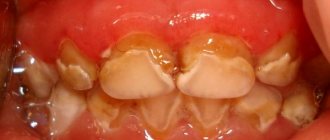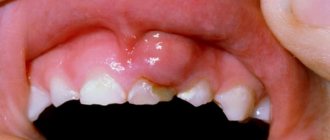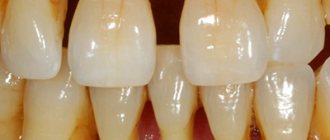Gothic sky - what does it look like, can it be treated, with what device?
Gothic palate is an inherited condition that causes a variety of symptoms, including malocclusion or speech impediments, and difficulty feeding the child. What does such a defect look like? The hard palate is high and narrow (reminiscent of tall Gothic buildings). Treatment mainly involves tongue exercises. In advanced cases, a device or surgery is used (to expand the jaw in adults).
Fotolia
Symptoms of oral candidiasis
The main sign of thrush in an infant is a permanent white coating, reminiscent of cottage cheese or yogurt, on the tongue, palate, gums, inner surface of the cheeks, and lips. At first it looks like small spots (“plaques”), which gradually grow. If you remove them with a bandage, a bright red inflamed mucous membrane is revealed.
As the disease progresses, the white spots become yellow or grayish. Small bleeding erosions form under them. The child experiences discomfort, therefore behaves restlessly and sleeps poorly. When sucking, the unpleasant sensations intensify, as a result, many infants refuse to eat.
In severe cases, fungal microflora leads to the formation of a dense film on the oral mucosa. Over time, it spreads to the throat, tonsils, esophagus and internal organs. The child may have a fever and a significant deterioration in general condition.
Gothic sky - what does it look like (symptoms)?
When this defect is detected, the hard palate is high, but at the same time narrow. The name comes from the shape, which is reminiscent of tall but slender Gothic buildings. People with this defect have trouble touching the tip of their tongue to the top of their mouth, which is often the main diagnostic test.
Due to the location of the palate within the oral cavity, diagnosis can be difficult, and diseases of the upper palate are often overlooked. In addition to differences in appearance between a healthy palate and a diseased palate, there may be differences in functioning, for example:
- Difficulty with the baby taking liquid food – breastfeeding can be significantly difficult due to problems with pressing the breast to the roof of the mouth and eating; with a gothic palate, you need to choose the right nipple;
- vicious swallowing, which is caused by the difficulty of raising the gothic tongue upward; the tongue remains displaced (this is called baby swallowing);
- poor respiratory tract - through the oral cavity, not the nasal cavity; this is seen as parted lips during the day and sleep with an open mouth;
- malocclusions – for example, crossbites or forehead defects;
- difficulty eating solid foods: biting, chewing, swallowing;
- speech defects – rhotacism (incorrect pronunciation of the letter “r”), lambdacism (incorrect pronunciation of the voice “l”), sigmatism (lisp).
About
The child's sky is normal photo
When the baby gets sick, the mother tries to independently examine the child’s throat before the doctor arrives, but she can’t really make out anything.
This is because there is no clear idea of what a healthy throat should look like and what a sick one should look like.
Redness of the larynx is not always a sign of a serious illness, and the absence of redness, which in most cases mothers try to see, is not always a sign of health. We need to figure everything out in order.
Symptoms
Children often have a sore throat; there can be many reasons - from allergies to chemical burns, but most often children are affected by respiratory viruses. There may also be bacterial inflammations and injuries.
You need to see what is happening with the child’s neck when the baby begins to show certain symptoms or openly complain about them:
- pain when swallowing;
- labored breathing;
- runny nose;
- headache, chills;
- sudden fever, increased temperature;
- enlargement of the submandibular lymph nodes;
- refusal to drink and eat.
How to conduct an inspection?
If a mother glances at the throat of a child who sluggishly makes an “ah-ah-ah,” this cannot be considered an examination.
There are certain rules for examining the throat:
- The child should be placed near a window facing the sunny side. If there is no such window or there is not enough natural light, you can use a small flashlight.
- It is clear that not every home has a medical spatula, but everyone has an ordinary tablespoon. With clean hands washed with soap, take a clean spoon and pour boiled water over its handle. After this, you no longer need to touch the handle with your hands.
- Using a spoon, gently press down the middle of your tongue. If you press on the tip, you may not be able to see anything. If you press on the root, the child will definitely vomit, since this is the simplest and easiest way to induce a gag reflex.
- The tonsils are best visible , but to assess their condition you need to ask the child to open his mouth as wide as possible so that the tongue is pressed to the lower lip.
- To assess the condition of the posterior wall of the larynx , it makes sense to lightly press the tongue with a spatula or spoon.
- The child should breathe through the mouth, taking deep breaths , during which the tongue reflexively lowers slightly. This makes it much easier to see the area of the tonsils and lateral parts of the larynx.
In order not to confuse the palatine tonsil with the pharyngeal tonsil, you need to at least have a general idea of the structure of the throat.
Norm
A normal healthy throat looks like this:
- There are no visible changes, wounds, or ulcers in the oral cavity. The tongue is clean, with little or no physiological coating.
- The tonsils are not enlarged, symmetrical, and have a pale pink tint. Plaque, blisters, ulcers, enlarged tubercles with pronounced boundaries and seals are not visible on them.
- The palate and palatine arches have a pink color - sometimes more, and sometimes less saturated, but uniform. There are no plaques, ulcers, or spots on them.
- The lateral parts of the larynx are normally not swollen, pink.
- The back of the larynx, rich in blood vessels, may be redder than the rest of the throat, but the condition of the vessels should be assessed exclusively - whether they are enlarged, whether there are pronounced tubercles, ulcers and plaque.
What does the pathology look like?
Visual signs of a sore throat are much more varied and indicate very specific diseases. An accurate diagnosis can only be made by a qualified doctor, who will be based not only on an examination of the throat, but also on the total value of other symptoms, as well as the results of laboratory tests.
However, knowledge of the distinctive signs of throat pathologies has never bothered any parent. This is useful at least to know in which cases to urgently call an ambulance, and in which to go to an appointment at the clinic or call a doctor at home.
In the early stages of tonsillitis, the tonsils become bright red, after a few hours they become covered with a white coating. Ulcers and individual areas of a purulent or necrotic nature may appear. The lumen of the larynx may be narrowed. With such inflamed tonsils, nearby lymph nodes may become enlarged.
Sore throat is always accompanied by high fever and severe intoxication. After an acute period, follicular tonsillitis may begin, which is clearly distinguishable upon examination due to a clear sign - loose purulent plaque on the tonsils.
To learn how to recognize a sore throat, watch the following video.
- Necrotizing tonsillitis is characterized by dead gray areas of lymphoid tissue on the tonsils, sometimes the process spreads to the palatine arches and the tongue.
- Fungal tonsillitis , as a rule, is accompanied by redness and inflammation of the tonsils, the appearance of visual looseness, as well as a yellowish-green coating. Throat fungi are most often related to the genus Candida.
- Pharyngitis is a common childhood disease that quite often begins to develop with a viral disease, with allergies, with some fungal infections (less often), as well as with bacterial infection. Almost all types of pharyngitis affect the mucous membrane of the larynx.
- In the simplest form ( catarrhal pharyngitis ), there is slight redness, as well as slight swelling in the larynx, which does not affect either the tonsils or the palate.
- With a visible increase in the pharyngeal tonsils, pronounced redness and swelling of the larynx itself, we can talk about possible hypertrophic pharyngitis .
- Atrophic pharyngitis is associated with atrophy of the mucous membrane, the throat is “lacquered”, a clear sign is the vessels on the back of the pharynx. They become larger, visually there are fewer of them.
Source: https://venyvarikoz.ru/nebo-u-rebenka-norma-foto/
Gothic sky – treatment, surgery
In case of suspected gothic palate or disease, doctors specialize in orthodontist, ENT and speech therapist.
This palate defect is easier to treat in children than in adults. The sooner therapy is started, the more satisfactory the effect of treatment will be.
The main treatment is to perform exercises that improve the vertical movement of the tongue and strengthen the muscles of the jaw and lips. Breathing exercises are also necessary to ensure proper breathing through the nasal cavity rather than through the mouth.
DiGeorge (Georg) syndrome: main symptoms, causes and diagnosis, prognosis
DiGeorge syndrome (DiGeorge syndrome, DiGeorge syndrome, dysembryogenesis syndrome of the 3-4 branchial arch, congenital aplasia of the thymus and parathyroid glands) is a type of idiopathic isolated hypoparathyroidism. It is a rare congenital disease.
About DiGeorge syndrome
The study of diseases of the immune system today is one of the youngest, but actively developing areas in medicine. An immunodeficiency state is a disease of the body's defense systems.
One example of these pathologies is DiGeorge syndrome, which is characterized by the congenital absence of the thymus gland, which contributes to the normal production of T lymphocytes. They help the body resist germs and infections.
Inactivity of the parathyroid glands is another component of DiGeorge syndrome, which results in insufficient levels of calcium in the blood. DiGeorge syndrome is also accompanied by a large number of anomalies in the development of organs and body systems.
The first description of DiGeorge syndrome dates back to 1965 and belongs to the American pediatrician and endocrinologist A.M. DiGeorge. The disease is quite rare, affecting only 1.5 - 3% of newborns, in an equal proportion in both boys and girls. Let's take a closer look at what kind of disease this is, what causes it, the signs of its occurrence, and whether DiGeorge syndrome can be treated.
Development of the disease
DiGeorge syndrome is characterized by complete or partial underdevelopment of the thymus gland (thymus). This organ is located in the chest cavity in children and is necessary for the formation of a cellular immune response.
During puberty, the thymus begins to decrease in size and transform into adipose tissue. This process is normal and does not relate to pathology. With DiGeorge syndrome, we are talking about the congenital absence of this organ or its insufficient development (hypoplasia).
As a result, immune cells remain defective and do not perform their functions. In addition, with this disease, there is often a lack of parathyroid glands, which are responsible for the exchange of calcium and phosphorus in the body.
The mechanism of development of anomalies of various systems is associated with disturbances in the intrauterine development of the fetus that occur in the early stages of pregnancy.
Diagnosis of pathology
The diagnosis of DiGeorge syndrome is made after listening to the patient’s complaints, collecting an anamnesis of life and illness, and conducting a series of diagnostic procedures.
- The patients' medical history includes frequent and severe infectious diseases, tooth decay, bone fractures, cardiac dysfunction, impaired psychomotor development, and strabismus.
- During a visual examination, the doctor determines characteristic changes in the facial skeleton and craniofacial dysmorphia, and upon auscultation hears specific heart murmurs.
- Immunogram - decrease in T-lymphocytes and immunoglobulins, dissociation between a decrease in T-cells and an increase in B-lymphocytes.
- In the blood - lymphopenia, hypocalcemia, hyperphosphatemia, hypogammaglobulinemia.
- Ultrasound, MRI and x-ray of the mediastinal organs confirm the absence of the thymus.
- Echocardiography - abnormalities of the cardiovascular system.
- Genetic research is a method of DNA hybridization or multiplex PCR.
- Amniocentesis is an invasive procedure that can detect microdeletion syndrome before the baby is born. This method of prenatal diagnosis is considered very traumatic and can result in premature birth. The DNA test is 99% accurate. Fetal DNA is isolated from the blood of a pregnant woman and examined for chromosomal abnormalities. Prenatal diagnosis allows you to identify genetic abnormalities in the fetus and resolve the issue regarding the outcome of pregnancy.
Based on the data obtained, a diagnosis of pathology can be made to the baby already in the maternity hospital. Comprehensive diagnostics makes it possible to determine the severity of the disease, predict the patient’s future life and prescribe competent treatment.
Treatment of the disease
There is no etiological therapy to correct the genetic mutation in DiGeorge syndrome. Therefore, symptomatic treatment is used.
To normalize calcium and phosphorus levels, replacement therapy is prescribed.
Effective treatment for immunodeficiency in this pathology has not been developed. There is evidence of successful thymus transplantation in a newborn, as well as the possibility of bone marrow transplantation.
Defects of the maxillofacial area are corrected at an older age.
Forecast
The prognosis of this disease is extremely unfavorable. Without treatment, children die in the first year of life from heart failure and severe infectious diseases. With timely treatment, life expectancy increases.
In the modern world, research is being conducted that is aimed at finding effective treatment for DiGeorge syndrome.
Prevention
As with most diseases associated with genetics, there is no specific prevention for DiGeorge syndrome. However, in order to avoid pathologies of fetal development, the expectant mother should follow certain recommendations.
When planning a pregnancy, a woman needs to receive a set of antiviral vaccinations.
Vaccination against rubella
Rubella does not pose a serious danger to an adult, but can provoke irreparable disorders in the fetal central nervous system.
Vaccination against measles
Measles is a serious viral disease that poses a threat to the health and life of both the fetus and the mother.
You may need to get any more vaccinations as prescribed by your doctor.
- Give up bad habits: smoking, alcohol, drugs;
- Protect yourself from infections and viruses;
- If possible, limit stress factors;
- If the mother has partial immune disorders, do not neglect preventive antimicrobial therapy, which can be prescribed by the attending physician.
Gothic palate – chamber
When the defect is more severe, a palate expansion device designed to widen the jaw must be used. Palatal suture expansion devices such as the Hass device are best suited for this purpose.
Jaw enlargement in adults requires a lot of effort, and the orthodontic appliance is sometimes insufficient for this purpose as the only treatment for a gothic palate. The orthodontist must collaborate with the surgeon because in such situations an operation is sometimes necessary - the so-called jaw distraction, which will allow the palatal bones to be properly expanded and the correct occlusal conditions between the dental arches to be obtained.
Prevention
The risk of developing candidal stomatitis is especially high in the first 6 months of a baby’s life, since his immune system is just developing. To prevent disease, it is important to follow the following rules:
- rinse your breasts with clean water before feeding;
- offer the baby some water after a meal or burping;
- strictly observe the rules of hygiene for all adults in contact with the child;
- Regularly sterilize bottles and pacifiers.
After an illness, to prevent re-infection, it is worth boiling all toys and children's dishes. If the item cannot be treated with hot water, it is recommended to rinse it with a soda solution.
The main reason for a white palate in a baby is the accumulation of food debris in the mouth after feeding. Traces of formula or milk disappear on their own and are not visible before the next meal. Persistent plaque in most cases is a sign of candidal stomatitis (thrush). This disease is treated with local and/or systemic agents with an antiseptic effect. At the initial stage, thrush is not dangerous, but as it progresses it can lead to the formation of ulcers on the mucous membrane and the spread of infection.
Gothic taste - effects
The effect of the Gothic palate on the patient is described in the previous paragraphs. In some people, the defect is diagnosed immediately after exposure because it does not cause any symptoms visible to the naked eye and the patient does not experience pain.
If left untreated, the disease causes: difficulties in eating and breastfeeding, malocclusion, articulation disorders and many others.
Vorobyova Marina
Neurologist of the highest qualification category (work experience 14 years), doctor of neurofunctional diagnostics (work experience 12 years); author of scientific publications on vertebroneurology; participant of scientific conferences on neurology and functional diagnostics of all-Russian and international significance.
About
Help for thrush
A pediatrician may suspect thrush based on an examination of the oral cavity. To confirm the diagnosis, it is worth taking a swab from the throat and determining the state of the microflora. If the number of Candida fungi exceeds the norm, the child has candidal stomatitis.
Local treatment
In most cases, local treatment of thrush is carried out in infancy. The safest method is to wipe the oral mucosa with baking soda. Stages:
- Prepare a weak solution of soda - 1 small spoon per 1 glass of boiled warm water.
- Wrap a sterile bandage around your clean index finger.
- Soak the bandage in a soda solution.
- Wipe the baby's mouth. There is no need to try to remove the plaque, just carefully treat it from above.
The procedure should be repeated every 2-3 hours for several days. If the child does not open his mouth, you should press your finger on the chin and hold it.
Another method of treatment is wiping the mouth according to the scheme described above with a solution of honey and warm water (in a ratio of 1:2). Honey has antimicrobial and anti-inflammatory effects. But you should remember that it is a very strong allergen.
If traditional methods do not help get rid of stomatitis, the doctor may prescribe external antifungal agents. Here are some of them:
- acidophilus powder;
- Candide solution;
- nystatin ointment;
- Shostakovsky balm;
- gentian violet solution and so on.
The method of their use is indicated in the instructions. Usually it is necessary to apply an ointment or solution to the mucous membrane several times a day. The duration and dosage are determined by the doctor.
Systemic drugs
In case of advanced candidiasis, systemic antimycotics are prescribed in parallel with local remedies in a dosage that is safe for a small child. The main drugs are Diflucan, Mycomax, Nystatin, Amphotericin B, Ketoconazole. They should be given to the baby for 5-10 days. It is important to follow the treatment period determined by the doctor, even if the symptoms of candidiasis have disappeared.
If your baby suffers from pain, you can give him ibuprofen in an age-appropriate dosage or paracetamol. In addition, it is advisable to use local analgesic gels, which are used during teething.
Along with the destruction of fungal flora, it is important to pay attention to increasing the child’s immunity. According to the doctor's decision, it is worth giving him B vitamins. If dysbiosis is present, it must be treated. It is recommended that a nursing mother undergo antifungal therapy with her baby, even if she has no symptoms.
How is the oral cavity of a newborn different?
A baby, unlike an adult, has delicate mucous membranes of the oral cavity, as well as lips and tongue. This is explained by the presence of a large number of blood vessels in the mucous membranes. A healthy baby's mouth and lips are bright pink, but with age they turn pale. The vulnerability of the mucous membranes of the baby's mouth and lips is also explained by their dryness, because salivation at this age has not yet been established.
The oral cavity of a newborn differs in structure from the mouth of an adult; it is maximally adapted for sucking. To achieve this, a child's tongue is significantly larger in percentage than an adult's tongue, and there is a special fold on the gums that ensures tightness. For the same purpose, nature has endowed the child with a kind of “suction cup” that can be felt on the baby’s upper lip.
What should you pay attention to?
As already mentioned, based on the condition of a newborn’s mouth, one can conclude that there are certain problems. The most common problems are thrush and stomatitis, but dealing with these troubles is quite simple; it is important not to miss the symptoms. However, a child’s oral cavity can also signal more serious pathologies associated with the baby’s development.
The baby’s tongue is normally located along the center line, but if parents notice that the baby’s tongue is constantly deviating to one side or the other, they need to sound the alarm. Most likely, the cause is damage to the cranial nerves and a visit to a neurologist should not be postponed. A tongue that is too large may indicate the presence of a hereditary disease or damage to the thyroid gland (hypothyroidism).
In what cases should you immediately call an ambulance?
In all cases where parents suspect a child has a throat disease, they should definitely consult a doctor. After examination and detection of the problem, in no case should you begin to self-medicate. The fact is that the symptoms of many of the diseases described above are similar, and a mother who does not see a sore throat in different people every day may well confuse the relatively harmless laryngitis and whooping cough, which is very dangerous for children under 2 years of age.
Ulcers in the throat can also be misleading, as can a coating on the tongue, which is characteristic of many infectious ailments.
Therefore, only a doctor, who has not only special equipment for visual examination of the throat, but also a laboratory, can make the correct conclusion. He will quickly be able to answer the question of what pathogen has settled in the larynx and for how long, what antibiotics or antifungal drugs it is sensitive to.
There are symptoms that should make a sane mother immediately call an ambulance:
- Upon examination, a narrowing of the larynx is noticeable, making it more difficult for the child to breathe. This may indicate laryngeal stenosis. The condition is fatal, especially for young children.
- Upon examination, the mother noticed ulcers, ulcers in the throat (on any part of it), and at the same time the child had a high temperature (above 38.5-39.0 degrees).
- During a home examination, the mother saw bleeding vessels in the posterior wall of the larynx, and at the same time the child had a high fever and intoxication (with or without vomiting).
- Sore throat
- Doctor Komarovsky
- Healthy or sick?
- Pharyngitis
- Learn to rinse
- White plaque
- Angina
medical reviewer, psychosomatics specialist, mother of 4 children
Gothic palate is a pathology related to abnormalities in the development of the jaw and nasopharynx. The name is due to the shape of the palate, which is abnormally high (“arched”).











